Authentic Golden Milk (Turmeric Milk Tea)
Yes, this Golden Milk recipe is easy, traditional, and optimized for absorption, but the real clutch? It’s outrageously delicious. The key is not to overload it with turmeric, which can make it taste medicinal and bitter. Plus, using a balanced blend of spices adds flavor and warmth while enhancing its nourishing properties. Comfort in a cup!
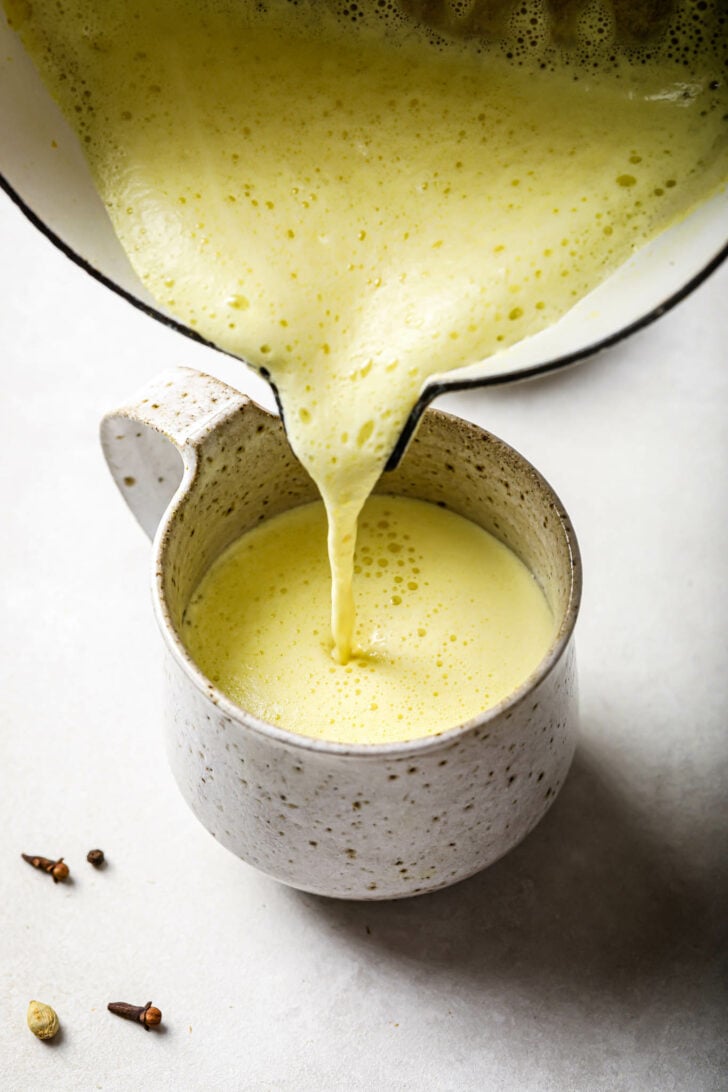
Want to save this post?
Enter your email below and get it sent straight to your inbox. Plus, get recipes & tips every week!
“So delicious—I’m sometimes super lazy and make it with commercial tea bags of golden milk blend, but your recipe is 1000x better, and I always regret not taking the extra few seconds to make a batch of the real deal. Making some again later this week, and can’t wait!”
Kathryn
I have a blog with the words ‘tea’ and ‘turmeric’, a blog that modernizes traditional recipes, a blog that celebrates the wisdom of South Asian cooking.
How could I not share Turmeric MIlk?
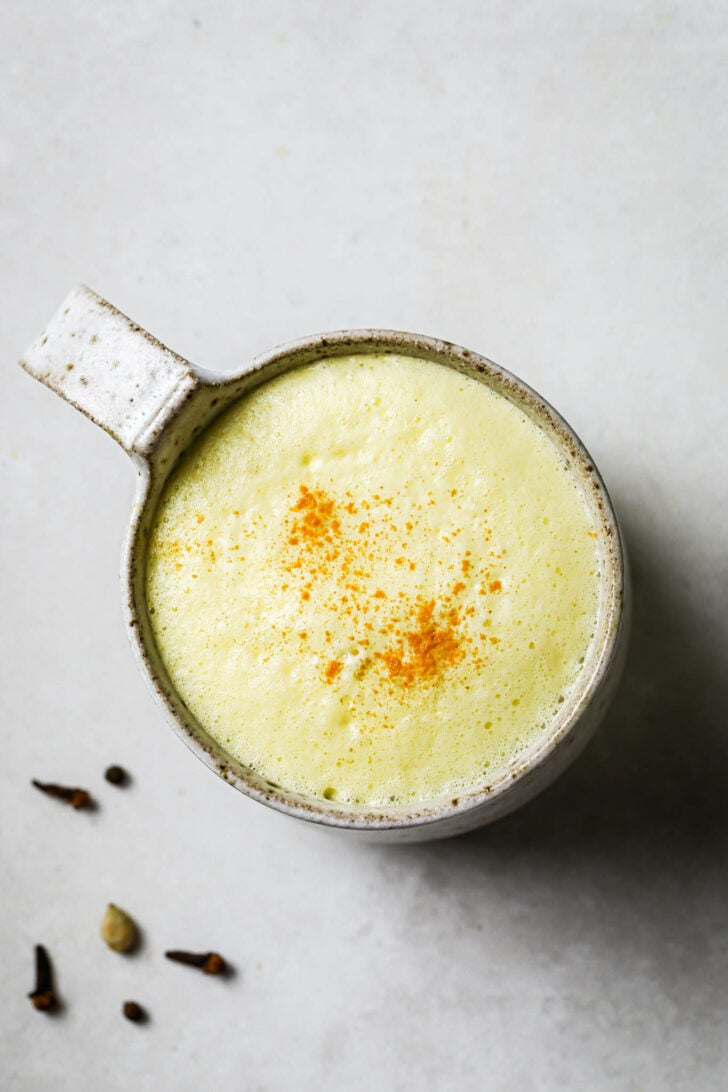
What is Golden Milk?
Turmeric Milk, or Haldi ka Doodh, is a nourishing Indian drink made with turmeric and milk. Here in the West, it’s often referred to as Golden Milk. Long used in ancient Ayurvedic medicine, Golden Milk is known for its anti-inflammatory properties.
Like Masala Chai, Turmeric Milk has evolved and morphed into so many beautiful drinks. Whatever the variation, the consensus is that it’s a life-giving drink that happens to taste (and feel) good!
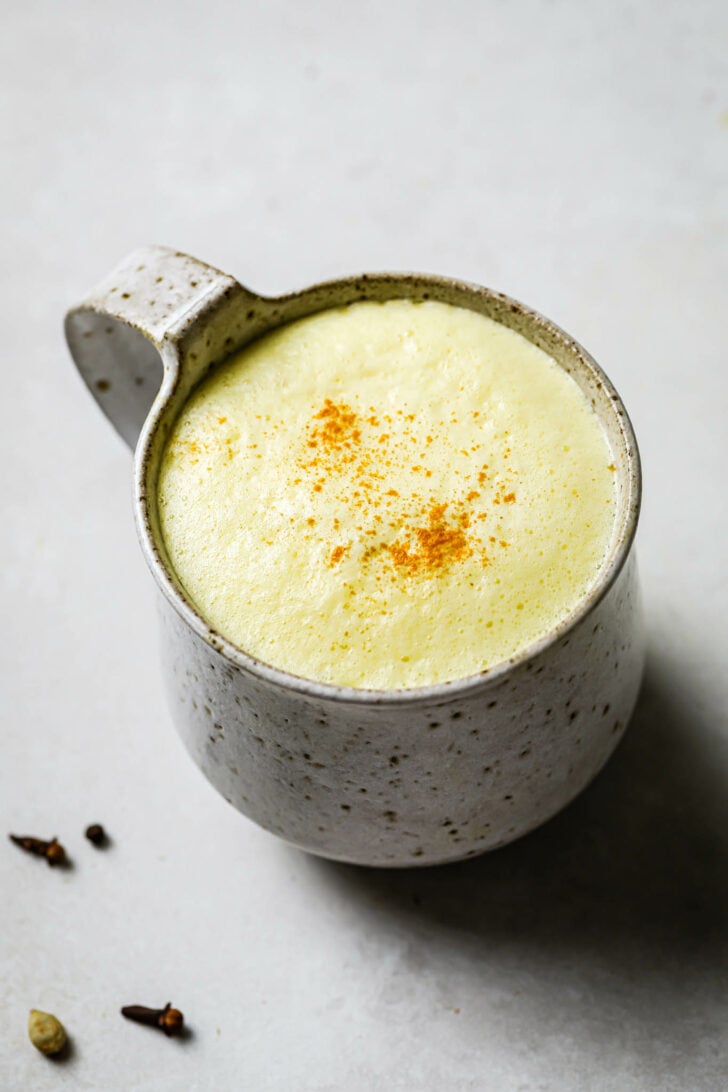
Difference between Modern Golden Milk and Traditional Turmeric Milk
Although the ‘traditional’ recipe varies from family to family (see Nandita Godbole’s deep dive into traditional vs trendy Golden Milk), there are some common themes I’ve noticed between the Turmeric Milk I grew up with and the reinvented version I most often see today.
| Traditional Turmeric Milk | Modern Golden Milk |
| usually made with turmeric powder | sometimes made with fresh turmeric root |
| made with whole milk | often made with alternative milks |
| not frothed | frothed |
| simple, with minimal flavoring | often enhanced with other spices & flavorings |
| sweetened with gud (jaggery), honey, and even sugar | sweetened with maple syrup or alternate sweeteners |
Though my recipe has invariably steered from the classic version (the vanilla is optional, I promise), the crux is there – whole milk, turmeric powder, and traditional spices.
Ingredients
I know this recipe has a long list of spices. Feel free to substitute with ground spices, or omit the ones you don’t have on hand. Keep it as basic or supercharged as you’d like. Remember, besides the milk & turmeric (and arguably a sweetener), almost everything else could technically be optional.
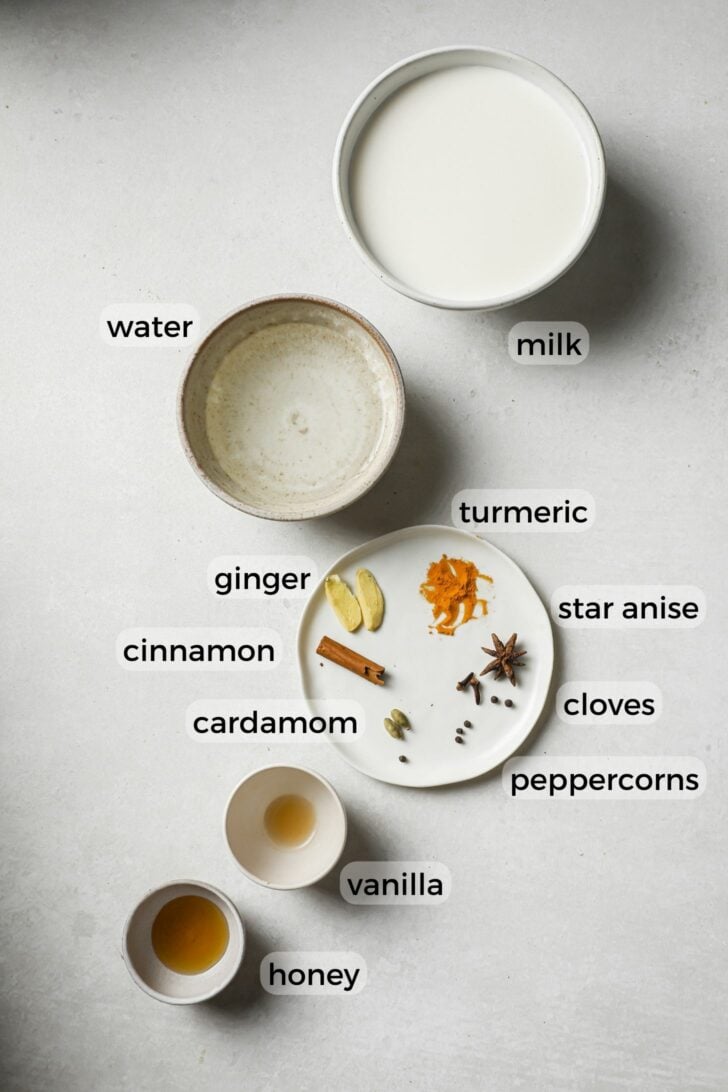
- Water: Accounts for evaporation and prevents the drink from getting heavy.
- Milk: Whole milk is traditional but you can use any dairy-free milk such as almond milk, coconut milk, or oat milk. If using a low-fat milk, see note on how to optimize for absorption.
- Black peppercorns: The piperine (the compound in black pepper that enhances turmeric absorption) in black pepper makes it an essential ingredient if you’re aiming to get the most health benefits. I’d suggest either using whole or freshly ground peppercorns, as pre-ground black pepper may have lost its beneficial properties.
- Cinnamon stick and Cardamom pod: Often added to traditional recipes for the flavor and health benefits.
- If substituting powder, use 1/8 tsp ground cinnamon and a generous pinch cardamom powder.
- Clove: This could very well be optional, but throw one in if you’ve got it.
- Sweetener: I most often use honey, but you can use any you’d like.
Optional Ingredients
- Star Anise: Adds a subtle floral taste. I usually break off a piece of the star anise instead of using the whole star. Since Star Anise is less likely to be found in most people’s spice cabinets (I use it for recipes like Biryani and Nihari), I’ve left it optional.
- Vanilla: Very much inauthentic, but isn’t everything at one point? 😇
- Ginger: I had Golden Milk at a café in L.A. and the ginger was almost unbearably intense, yet it ignited in me an inclination to throw a slice of ginger into my own turmeric milk. For stronger flavor, feel free to crush or mince the ginger.
- Ghee or coconut oil: In traditional recipes, ghee would be sometimes be added for extra nutrition and healthy fats.
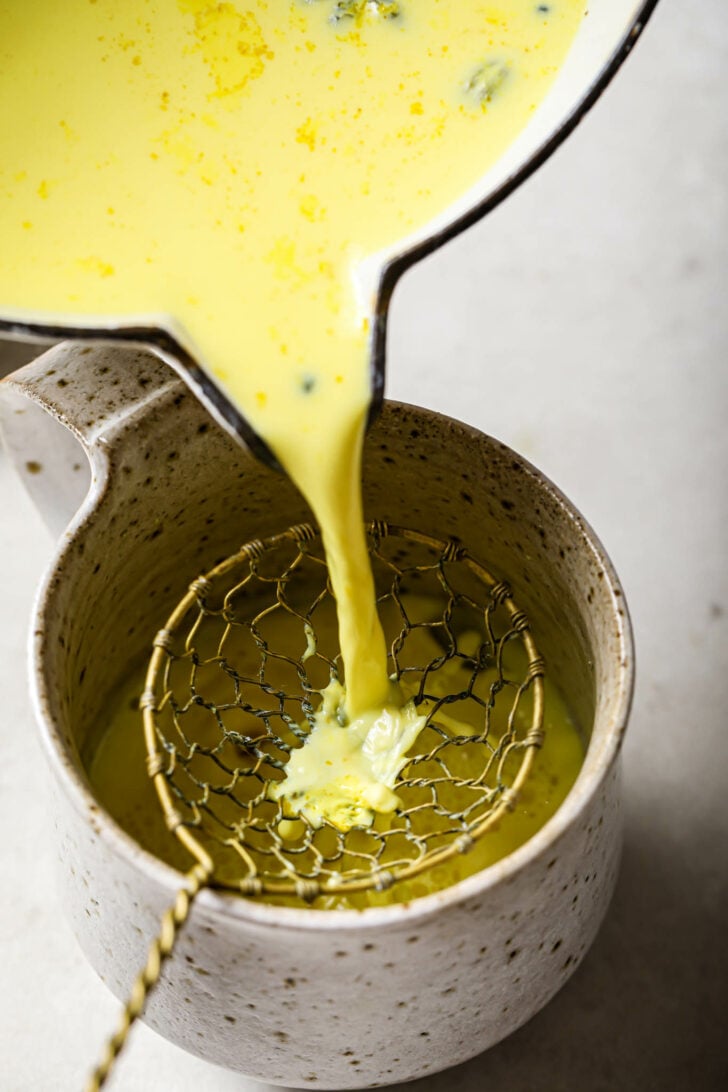
Turmeric Powder (Ground Turmeric)
- Quality: I wish I was fancy enough to always source the highest quality organic turmeric from reputable, single-origin sources. But reality dictates that I often grab the most vibrant colored one with the farthest expiration date from my local Desi store or supermarket.
- Quantity: More doesn’t always mean better. If you’re new to turmeric milk, start with 1/4 tsp, then add more according to taste and color (potency varies from powder to powder). I usually use 1/2 tsp, but any more than 1 tsp and it starts to taste medicinal and grainy.
Fun Fact: Curcumin, the active & most beneficial component of turmeric, is what gives turmeric its deep yellow color. Turmeric powders come with varying levels of curcumin content.
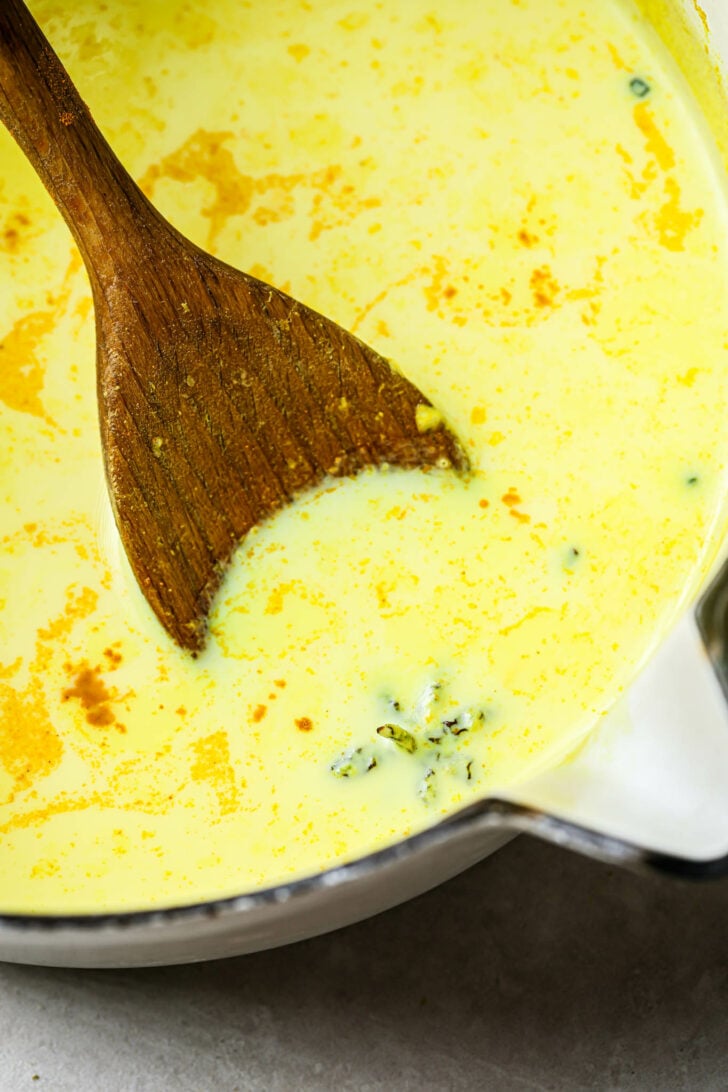
Nutritional Benefits of Turmeric
Full Disclosure: My expertise lies in taste, not nutrition, but I’ve linked several reliable (read .edu/.gov/.org) resources if you’d like to learn more:
- Turmeric has been used for centuries in Ayurvedic medicine as well as Traditional Chinese medicine.
- In a review of 700+ studies, turmeric was found to outperform many pharmaceutical drugs.
- The National Institutes of Health PubMed database listed nearly 5000 studies and articles on turmeric or curcumin (and that’s in January of 2015).
- Numerous studies have linked turmeric with a vast amount of anti-inflammatory and antioxidant effects.
And I’m just touching the tip of the iceberg here!
How to Make Golden Milk
Here’s the simple step-by-step:
- Place a saucepan over medium-high heat. I add water first to prevent the milk from sticking to the hot saucepan.
- Add all the ingredients but the coconut oil/ghee (if using) and sweetener.
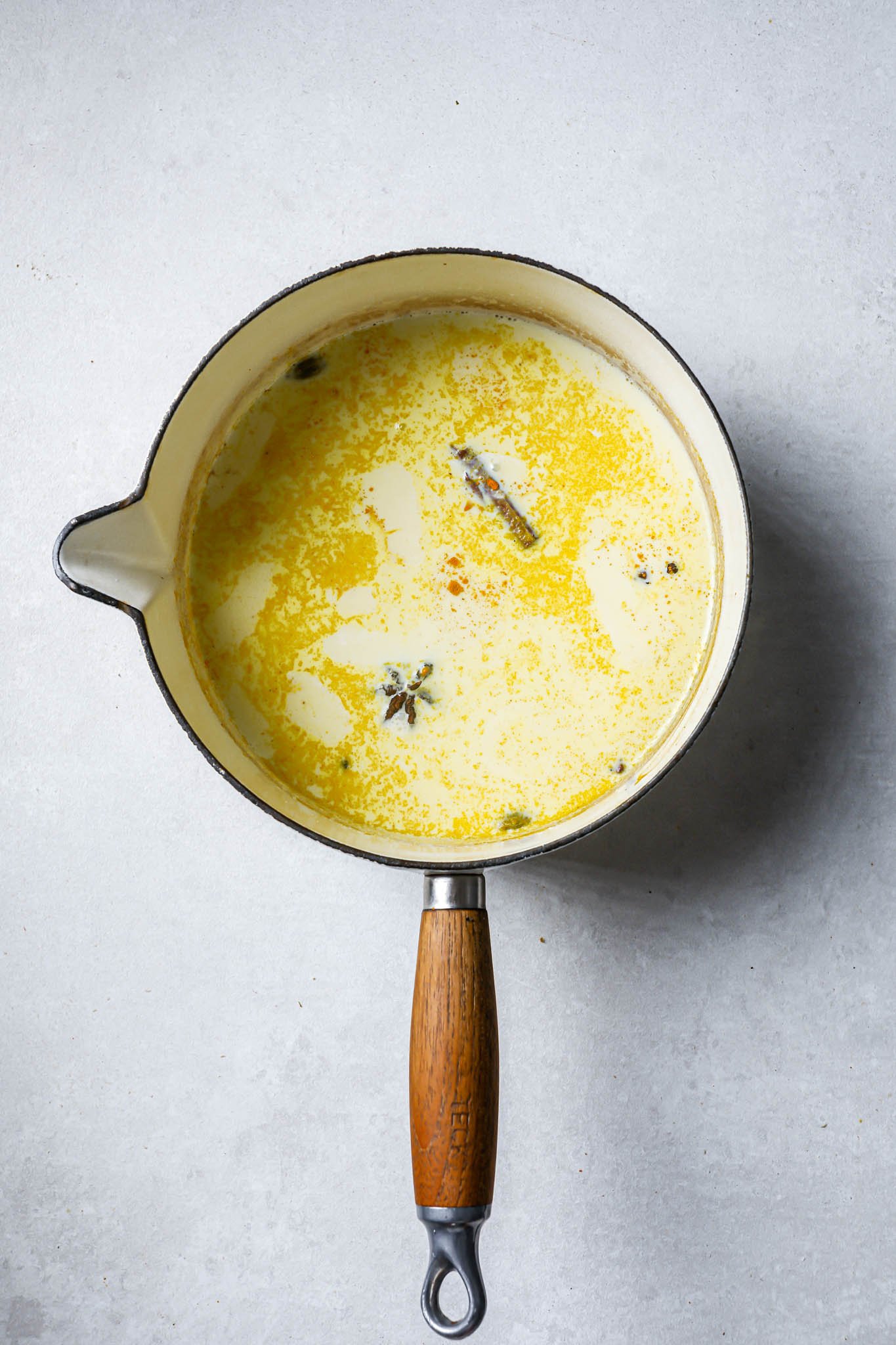
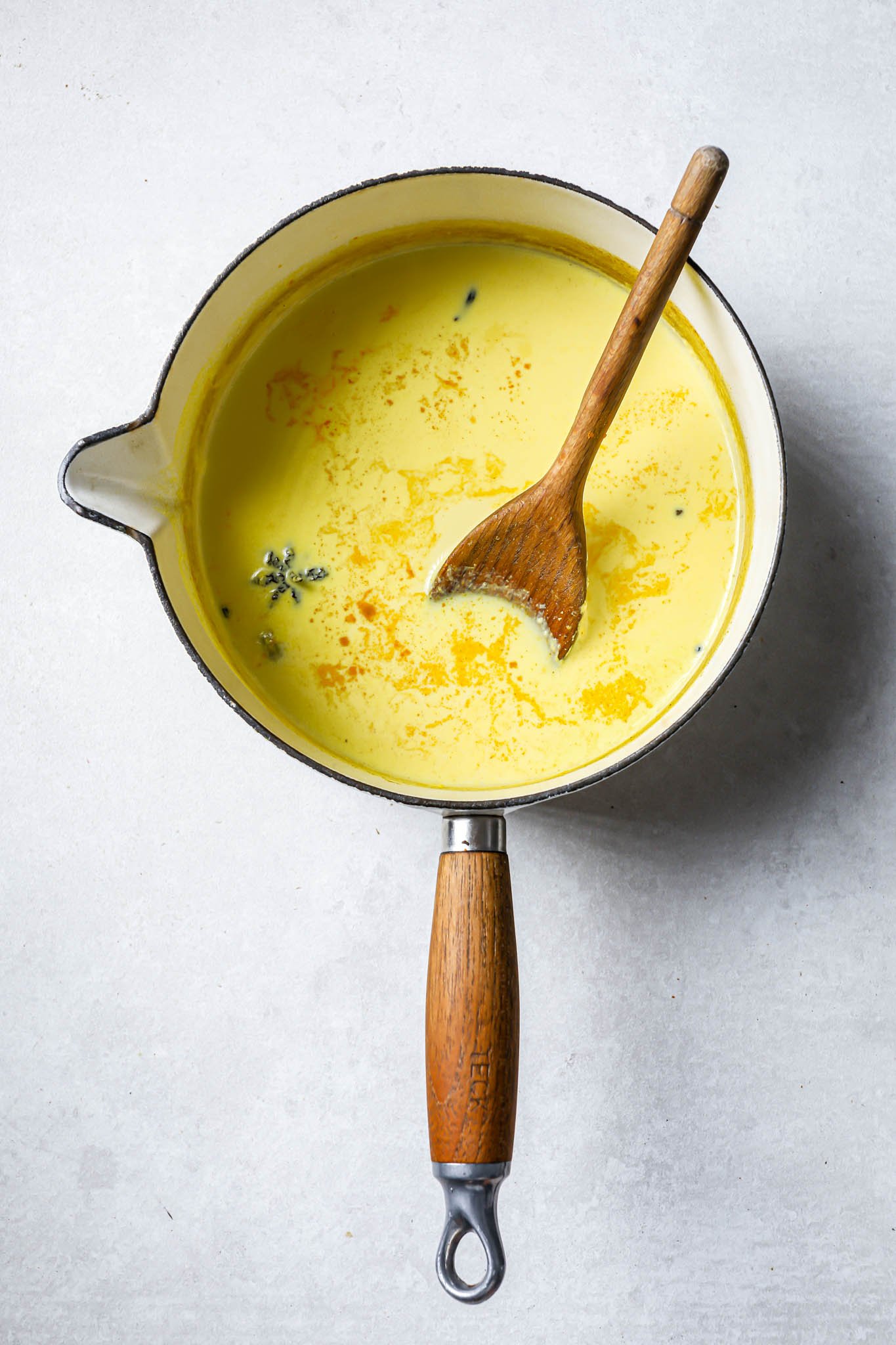
- Stir or use a whisk to combine.
- The key is make sure the turmeric powder dissolves into the milk before taking it off the heat.
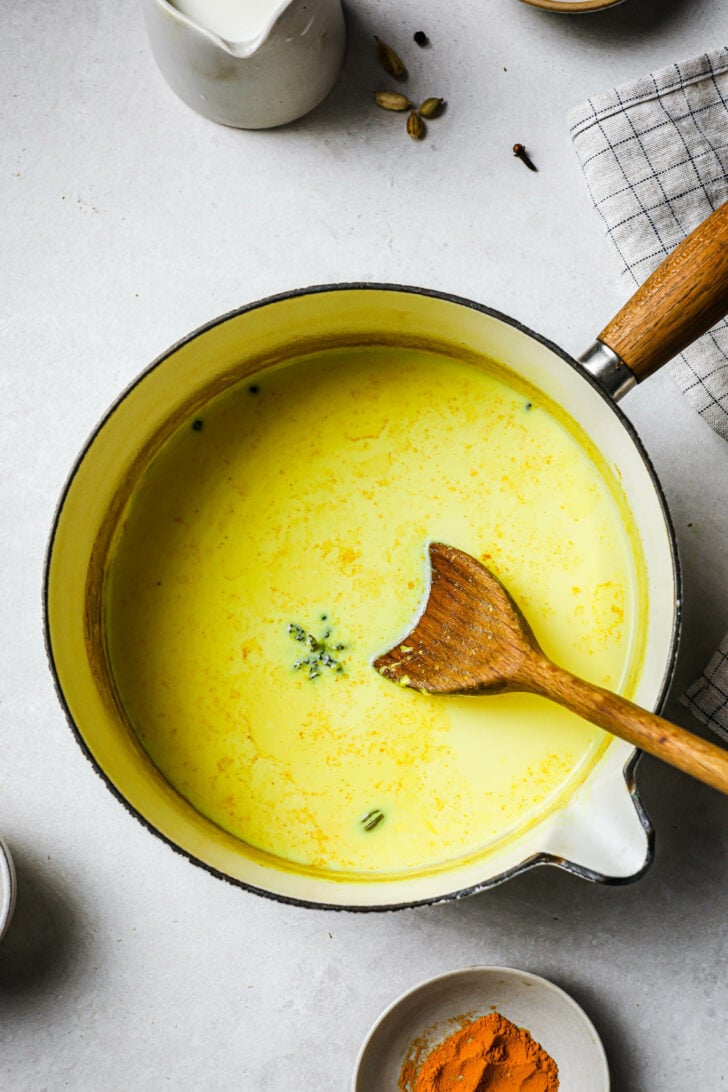
- If you’d like, simmer for a few extra minutes to infuse the spices even more. The turmeric will still retains its health properties.
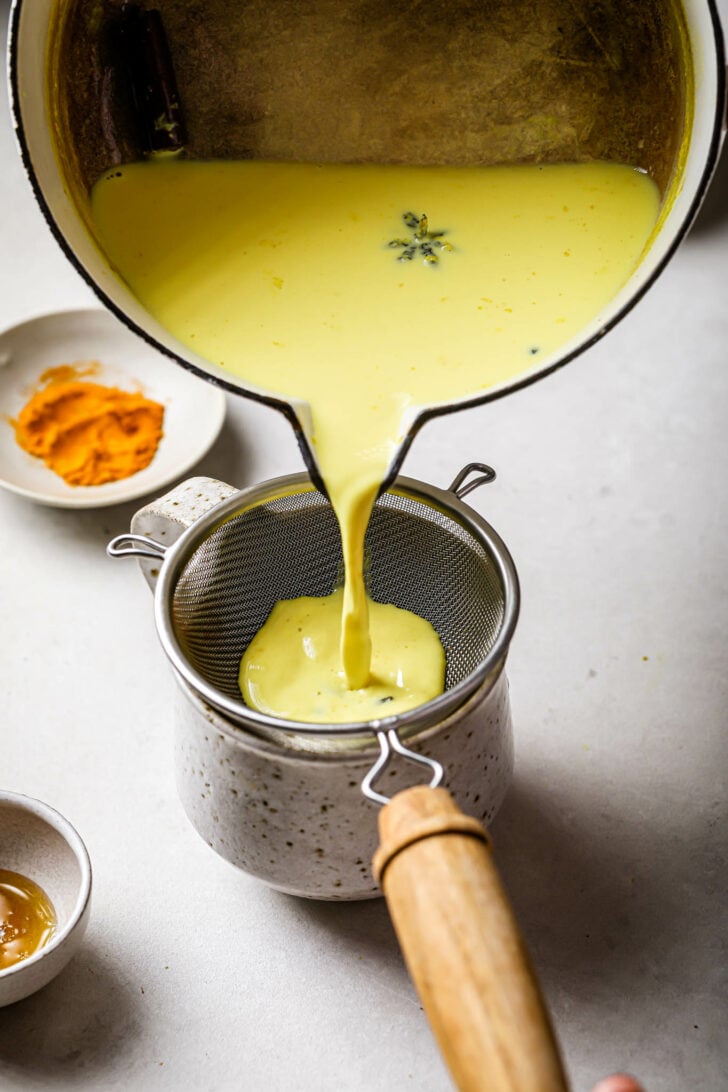
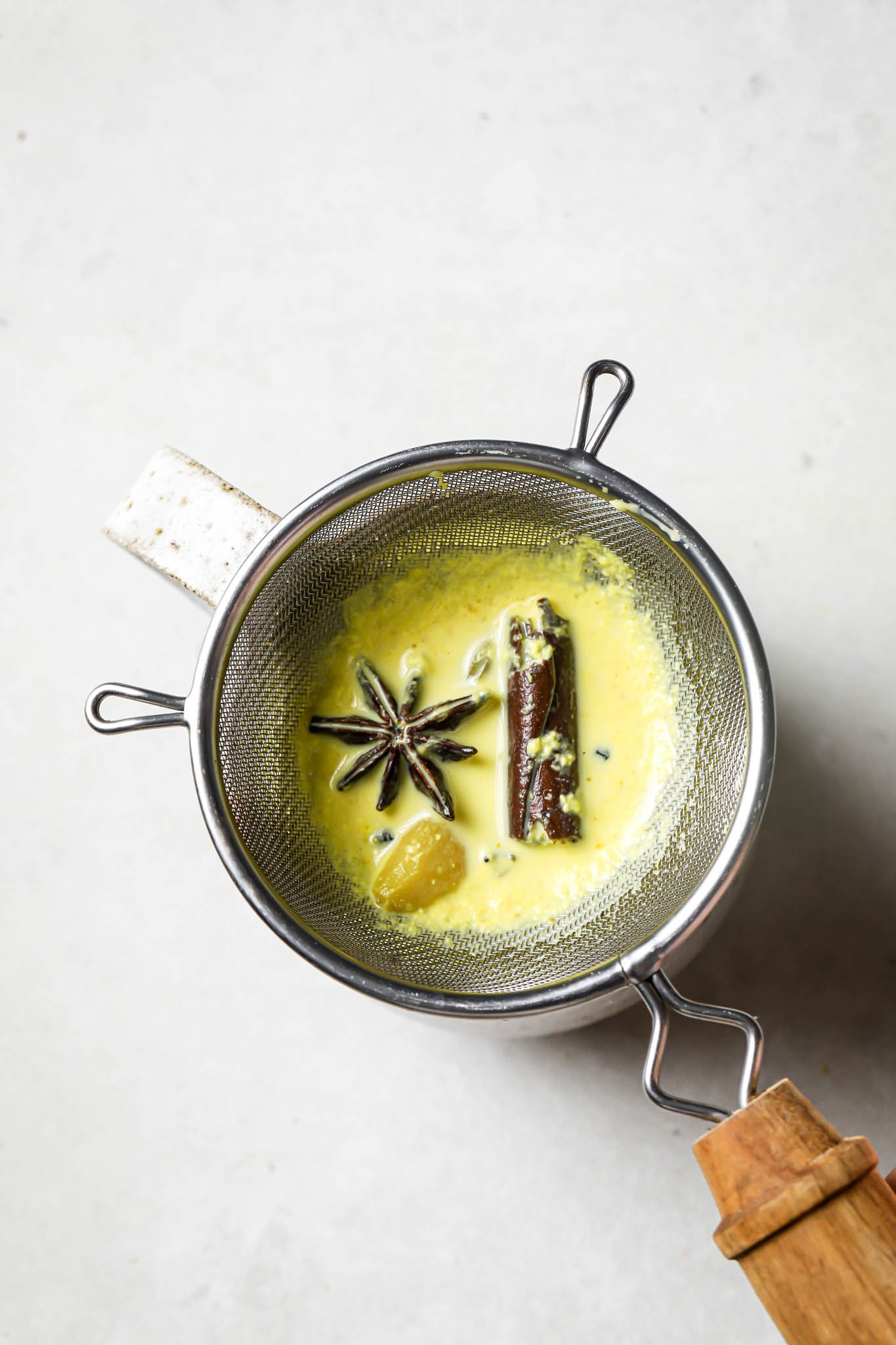
- Strain into your cup. Add ghee/coconut oil if you’d like.
- Sweeten to taste. 1 tsp honey is on the lower end, so taste and adjust if you’d like more.
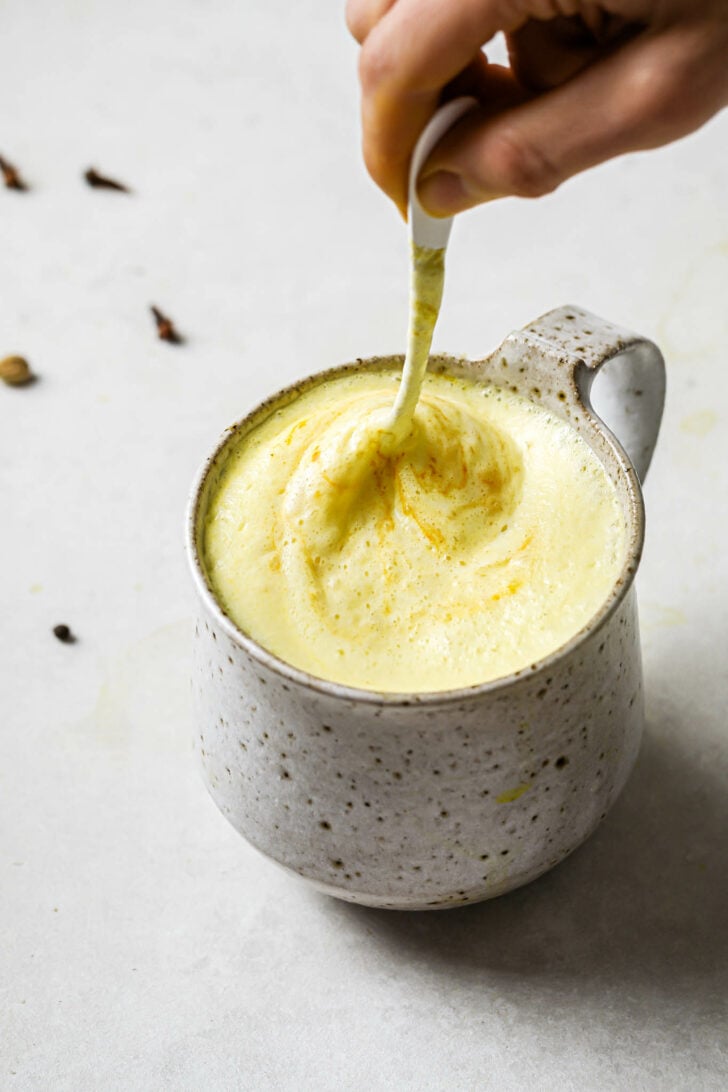
How to Optimize Turmeric for Absorption
Curcumin (the active compound in turmeric) alone is poorly-absorbed by the body, but a couple things help make it more bioavailable:
- Just a small amount of black pepper increases the bioavailability of the turmeric by 2000%.
- Because both piperine and curcumin are fat-soluble, turmeric is better absorbed with a fat. For example, turmeric is often used in curries, where there’s always a fat element.
- Though the fat content in whole milk may be enough, I’ve included the option to use coconut oil or ghee if you’re using a low-fat dairy-free milk such as rice milk.
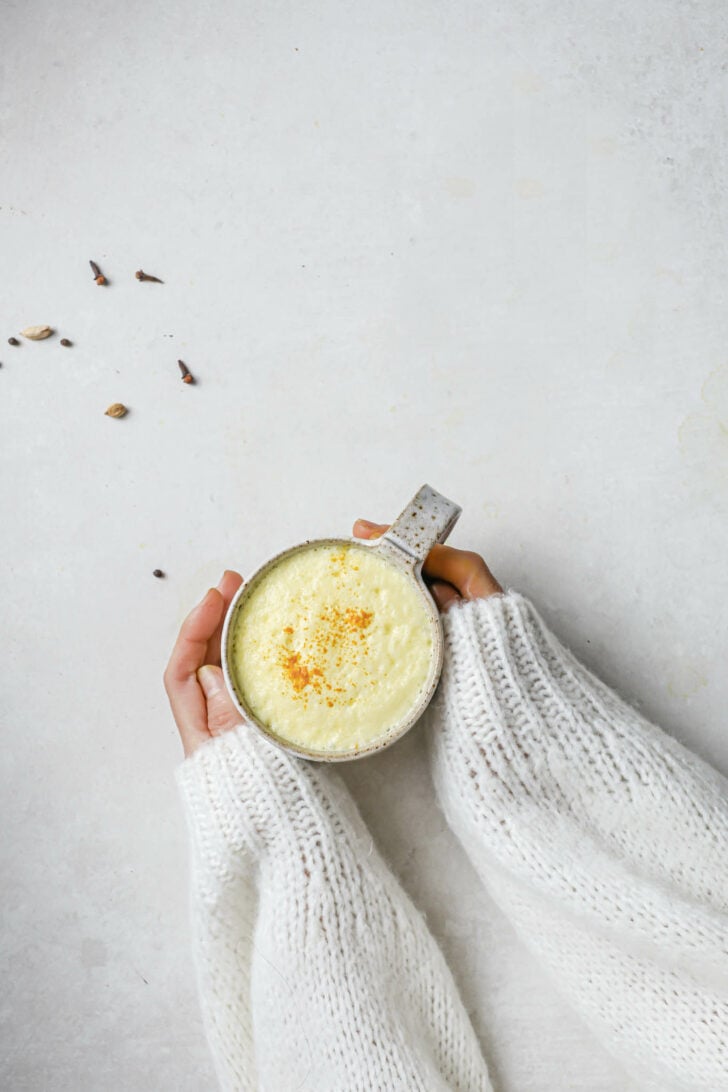
With all this talk about its medicinal properties, I don’t want to undermine that this drink is truly delicious! The warming spices, the full-bodied, earthy taste, and the soothing aroma…as cliché as it sounds, it’s not just a drink, it’s an experience. So slow down, relax, and focus on how you’re nourishing your body while enjoying a unique and flavorful beverage. If you try it, I’d love to know in the comments below!
More Pakistani and Indian Drink Recipes
- Authentic Pakistani Chai
- 20-Minute Kashmiri Chai Recipe (Pink Tea)
- Masala Chai
- The Best Mango Lassi
- Sweet Lassi
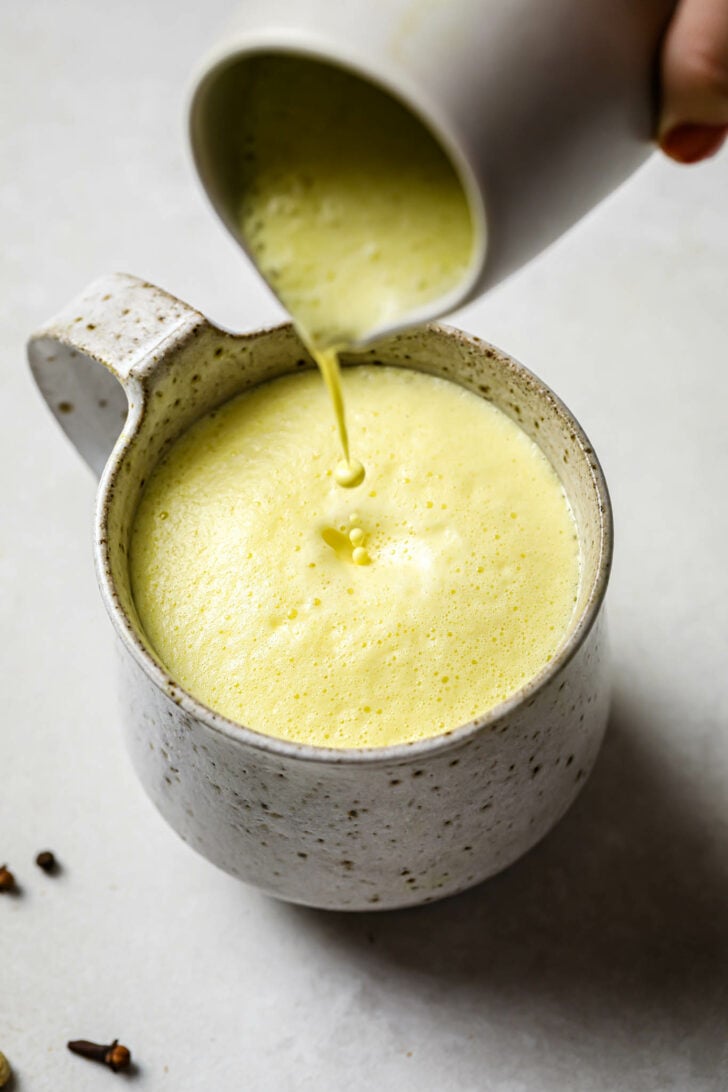
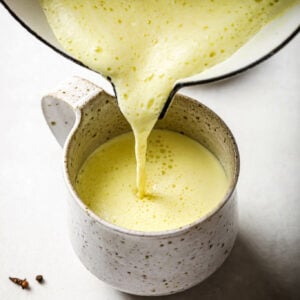
Authentic Golden Milk (Turmeric Milk Tea)
Watch the Video
Ingredients
- 1/2 cup water
- 1 cup whole milk, almond, soy or coconut also work well though milk is traditionally used
- 1/2 tsp turmeric powder, (See Note 1)
- 1 green cardamom, slightly cracked open
- 1 clove
- 1- inch piece cinnamon stick
- 3 black peppercorns
- 1 small star anise, optional
- 1/2 tsp vanilla extract or 1/4 vanilla bean (scraped), optional – (See Note 2)
- 1 thin slice fresh ginger, optional
- 1/4 tsp ghee or coconut oil , optional – (See Note 3)
- 1 tsp honey, jaggery (gud), or sweetener of choice, plus more to taste
Equipment
- Small Saucepan
Instructions
- Heat a saucepan over medium-high heat. Bring all of the ingredients except coconut oil/ghee and sweetener to a simmer.
- Stir well and lower the heat to a low or low-medium (you want it to simmer but not boil). Cover with the lid ajar and allow the milk to simmer for 5 minutes, depending on how strong you want the flavor of the spices (up to 10 minutes).
- Turn off the heat and strain into your cup. Stir in coconut oil/ghee (if using) as well as your sweetener. Delight in the warmth and comfort of therapeutic golden milk.
Notes
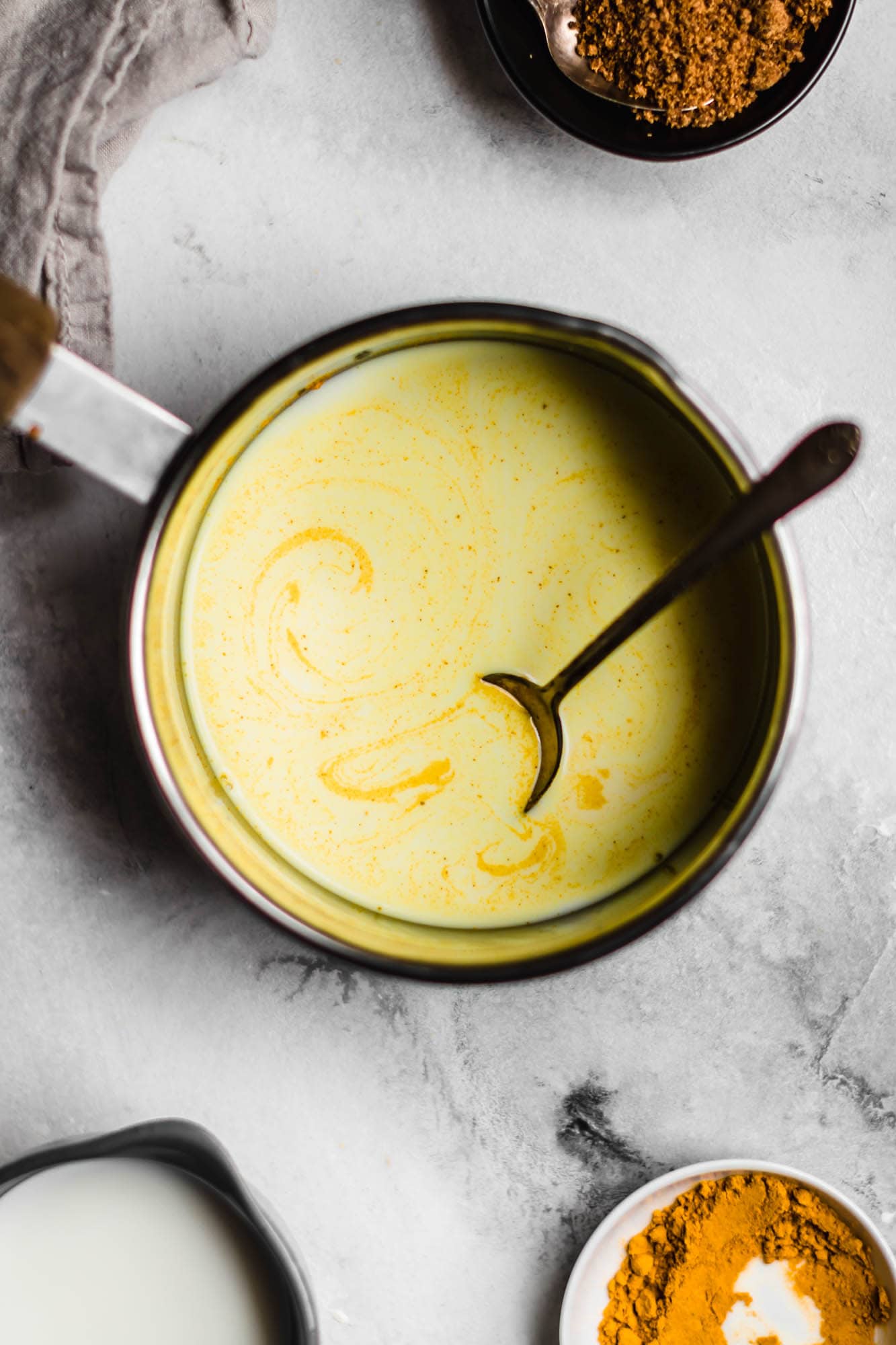
This post is an updated version of the one I originally published on December 3, 2016. Since then, I’ve updated with new text, pictures, and video. The recipe, aside from a few tweaks, remains the same.


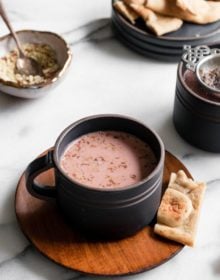
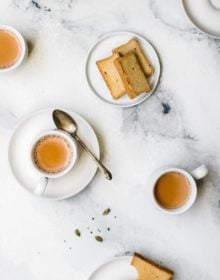
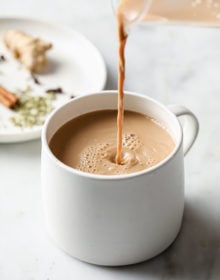
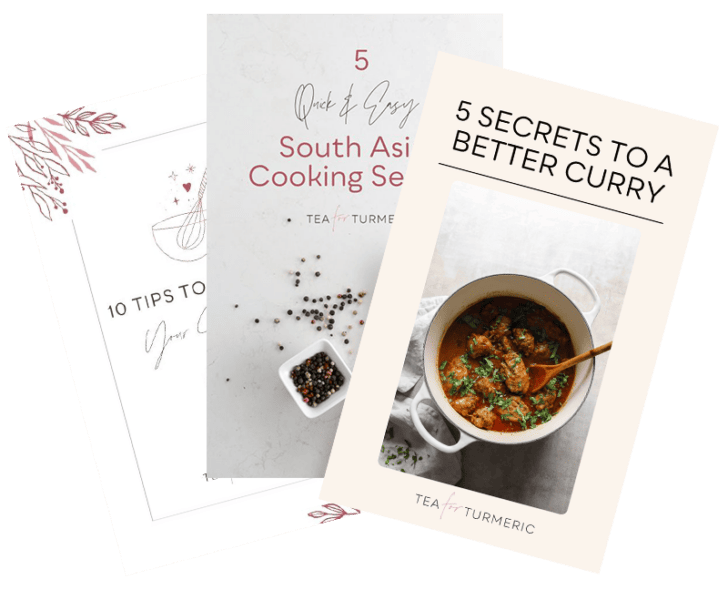
97 Comments on “Authentic Golden Milk (Turmeric Milk Tea)”
What is considered a leaf of star anise? Is it one of the points of the dried fruit? Thank you.
Hi Janelle, I meant just a small edge of the star or a broken piece. The exact size isn’t important, but I think a large star anise could be overpowering for some.
Great recipe. I love it. I first tried with coconut milk but will try whole milk next. Can this be consumed daily?
Hi Anthony! I would think yes, especially if you use the lower quantity. But you can consult with your doctor if you have any concerns.
I have tried making this a few times with turmeric powder bought from Indian grocery stores but have found a “sludge” like material in the bottom of my cup!
Is that normal or is the turmeric not pure?
I think that’s normal and happens to me as well!
So delicious—I’m sometimes super lazy and make it with commercial tea bags of golden milk blend, but your recipe is 1000x better, and I always regret not taking the extra few seconds to make a batch of the real deal. Making some again later this week, and can’t wait!
Also, I love how you navigate talking about the kind of milk to add, and that you encourage people to use real milk if they’re looking for the most traditional version, or an alternative milk if they can’t have real milk. I feel like that part of the story often gets lost in a lot of recipes out there, and that many recipes now seem to be made with vegan milk by default with no mention that it is a pretty major variation on the original—I worry that then people who aren’t familiar with the drink’s origin won’t really understand its roots, and that everyone will begin to assume that it’s supposed to be vegan. But it’s also so nice that you also say that it’s ok to use vegan milks as a substitute (I can’t have straight up milk, so I really appreciate that, and usually make mine with almond milk). Anyway, all to say, such a wonderful and important post, and so well done <3
Thank you so much, Kathryn. That’s very true – whole milk is highly regarded in South Asian cuisine. I’m so happy you liked it! I’ll have to try it with almond milk sometime. Thanks for sharing your review!
Can I use fresh turmeric? If so, how much should I use?
I have not tried it with fresh turmeric but a quick google search says you should use 3 times the amount of dried. Hope that helps!
I am not sure where to find these herbs, like where can I buy Whole Cardom , star anise leaf or turmeric . I have Mc cornice spice turmeric but t is not loose it’s packagd
You can find most of these spices at your local supermarkets in the spice aisle. I’d avoid purchasing star anise if you don’t plan to use it again. And McCormick Ground Turmeric would work for this recipe as long as it’s a powder!
Sorry, but this recipe is not authentic.
1.) According to over 5,000 years of Ayurvedic medicinal study, honey should never be heated or cooked, so it should never be used for this medicinal drink.
2.) Likewise, coconut milk should NEVER be used in this medicinal drink. It can only be boiled whole cow’s milk. For an explanation, do some research into the Ayurvedic view of cow’s milk, and why it is the only milk that works for this drink.
Hi Jill,
Thanks for your insight and knowledge! Regarding your first point, I have asked for honey/sweetener to be added *after* making the milk in the recipe so it is not cooked. I will update the wording for more clarity. On your second point, you’re right – we have grown up with cow’s milk being used to make turmeric milk. But I wanted to give a dairy-free option as well. I hope that helps and thanks again!
That’s a great recipe dear I will definitely give it a go
Hope you get a chance to try it!
I’m interested in it for inflammation, stomach issues, sleep and anxiety. Can you break down what each ingredient is best used for?
Hi Janet, the spices are all soothing and have various beneficial properties. I would hesitate to break down their best property simply because they’re complex and would benefit different people in different ways.
Hey where is the Ashwaghanda ? It’s a must have!!!!!
Hi Jp! Ashwagandha is an excellent idea but I do avoid it here as it is a medicinal herb and I don’t think it would be suitable for everyone. It is also not often added in everyday turmeric milk in most households.
Turmeric milk is a magical drink which contains many healthy contents. Its golden color & taste is so delicious,soothing with full of flavors. Thank you for sharing the recipe of golden turmeric milk. I liked it!